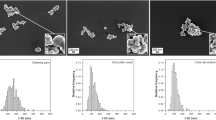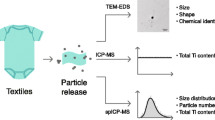Abstract
An integrated approach based on the use of inductively coupled plasma mass spectrometry (ICP-MS) and scanning electron microscopy (SEM) for the qualitative and quantitative analyses of metal particles in foods was devised and validated. Different raw materials and food products, like wheat, durum wheat, wheat flour, semolina, cookies, and pasta were considered. Attention was paid to the development of sample treatment protocols for each type of sample to avoid potential artifacts such as aggregation or agglomeration. The analytical protocols developed followed by ICP-MS and SEM investigations allowed us the quantitative determination and the morphological and dimensional characterization of metal nano- and microparticles isolated from the raw materials and finished food products considered. The ICP-MS method was validated in terms of linearity (0.8–80 μg/g and 0.09–9 μg/g for Fe and Ti, respectively), quantification limits (0.73 μg/g for Fe and 0.09 μg/g for Ti), repeatability (relative standard deviation (RSD) % equal to 10% for Fe and 20% in a wheat matrix as an example), and extraction recoveries (93 ± 2–101 ± 2%). Validation of the scanning electron microscopy–energy dispersive X-ray spectroscopy (SEM-EDS) measurements was performed working in a dimensional range from 1 to 100 μm with an estimated error in the size determination equal to 0.5 μm. ICP-MS data as well as SEM measurements showed a decrease in the concentration of metal particles from wheat to flour and from durum wheat to semolina samples, thus indicating an external contamination of grains by metal particles. These findings were confirmed by environmental SEM analysis, which allowed investigation of particles of lower dimensions. Generally, the largest number of particles was found in the case of iron and titanium, whereas particles of copper and zinc were only occasionally found without any possibility of quantifying their number.


Similar content being viewed by others
References
Burleson DJ, Driessen MD, Penn RL (2004) J Environ Sci Health A 39:2707–2753
Waychunas GA (2001) Nanoparticles Environ 44:105–166
World Health Organization (2006) Obesity and overweight. Fact sheet No 311
Liu S, Willett WC (2002) Curr Atheroscler Rep 4:454–461
Borzoei S, Neovius M, Barkeling B et al (2006) Eur J Clin Nutr 60:897–902
European Union (2009) Scientific Committee on Emerging and Newly Identified Health Risks (SCENIHR): Risk Assessment of Products of Nanotechnologies
Ludwig DS (2002) JAMA: Am Med Assoc 2414–2423
Cordain L, Eades MR, Eades MD (2003) Comp Biochem Physiol A Mol Integr Physiol 136:95–112
Koch AM, Reynolds F, Merkle HR, Weissleder R, Josephson L (2005) Chem Biochem 6:337–345
Brunner TJ, Wick P, Manser P, Spohn P, Grass RN, Limbach LK, Bruinink A, Stark WJ (2006) Environ Sci Technol 40:4374–4381
Bullard-Dillard R, Creek KE, Scrivens WA, Tour JM (1996) Bioorg Chem 24:376–385
Madden SG, Loeb SJ, Smith CA (2008) J Clin Nurs 17:2243–2256
Chaudhry Q, Aitken R, Scotter R, Blackburn J, Ross B, Boxall A, Castle L, Watkins R (2008) Food Addit Contam 25:241–258
House of Lord Science and Technology Committee (2010) 1st Report of Session 2009–10 Nanotechnologies and Food Volume I
Tiede K, Boxall ABA, Tear SP, Lewis J, David H, Hassellöv M (2008) Food Addit Contam 25:795–821
Grainger DW, Castner DG (2008) Adv Mater 20:867–877
European Union (2007) Scientific Committee on Emerging and Newly-Identified Health Risks (SCENIHR): Opinion on the appropriateness of the risk assessment methodology in accordance with the technical guidance documents for new and existing substances for assessing the risks of nanomaterials
Mavrocordatos D, Pronk W, Boller M (2004) Water Sci Technol 50:9–18
Giordano C, Bardi U, Garbini D, Suman M (2011) Microsc Microanal J. doi:10.1002/jemt.20978
The Fitness for Purpose of Analytical Methods: A Laboratory Guide to Method Validation and Related Topics (1998) EURACHEM Guide, 1st English Edition 1.0-, LGC (Teddington) http://www.eurachem.ul.pt/
Draper N, Smith H (1981) Applied Regression Analysis, J. Wiley & Sons (Editors), New York
Box GEP, Hunter WG, Hunter JS (1978) Statistic for Experimental, Wiley & Sons (Editors), New York
Suman M, Silva G, Catellani D, Bersellini U, Caffarra V, Careri M (2009) J Chromatogr A 1216:3758–3766
Author information
Authors and Affiliations
Corresponding author
Additional information
An erratum to this article can be found at http://dx.doi.org/10.1007/s00216-011-5241-7
Rights and permissions
About this article
Cite this article
Beltrami, D., Calestani, D., Maffini, M. et al. Development of a combined SEM and ICP-MS approach for the qualitative and quantitative analyses of metal microparticles and sub-microparticles in food products. Anal Bioanal Chem 401, 1401–1409 (2011). https://doi.org/10.1007/s00216-011-5149-2
Received:
Revised:
Accepted:
Published:
Issue Date:
DOI: https://doi.org/10.1007/s00216-011-5149-2




